
This page is part of © FOTW Flags Of The World website
Community of Portuguese-Speaking Countries
Comunidade dos Países de Língua Portuguesa, CPLP
Last modified: 2023-06-03 by  zachary harden
zachary harden
Keywords: cplp | community of portuguese-speaking countries | comunidade dos países de língua portuguesa | logo | international organization | border | waves: 7 | waves: 8 | disc (blue) |
Links: FOTW homepage |
search |
disclaimer and copyright |
write us |
mirrors
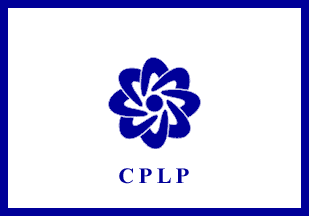
image by Francisco Grigoric and Sammy Kanadi, 01 Nov 2006
See also:
Other sites:
Membership and status
As far as I know, there are three official multicontinental
entities based on cultural ties: Commonwealth,
Francophonie and Lusophonia.
Pierre Gay, 03 Dec 1998
CPLP was created in 1996 as a strictly political-diplomatic
organization with the promotion of the Portuguese language as its only
cultural goal. Founding members were all the lusophonous countries
(Portugal,
Brazil, Angola,
Mozambique, Cape Verde,
Guinea-Bissau and São Tome e
Príncipe) and East Timor as an observer.
Jorge Candeias, 03 Dec 1998
East Timor is now a full member and no longer an
observer, increasing the number of member states to 8. This has direct
vexilological consequences, because the logo has now eight “fingers”
instead of seven.
Jorge Candeias, 29 Jan 2005
CPLP was indeed formed while Macau was still under
portuguese administration. And that’s why it was not in the list
of members: CPLP is an association of independent nations, and that was never
the case for that territory.
Jorge Candeias, 21 Mar 2004
The statutes of the CPLP say that «Besides the founding members,
any State can become a member of CPLP provided it uses Portuguese as an
official language and accepts without reservations the organization’s
statutes» (art. 6, par. 1). So, since Portuguese is one official languages
of the PRC, being one of the official languages of one
of its constitutent territories, China could become a member of CPLP, which
would create an interesting situation, to say the least.
The same could be said about Spain, because the
decision of weather Galician is a full fledged
language on its own or a variation of portuguese is largely political. If
Spain wanted to get in, it would simply have to start calling
Galician “Portuguese” and apply (and the tricky part: convince
the member-states to support unanimously their application).
And something similar could be said about other states where Portuguese
is not official, but is widely spoken, even as first language, due to large
immigrant populations or regional influence, such as
Andorra and Luxembourg or,
in Latin America, Paraguay, Uruguay
or Venezuela. If any of these states decides to make
Portuguese one of their official languages, they could also apply for
membership in the CPLP.
If Cabinda becomes independent, or
Madeira… So, in fact, the possibilities for
future changes in the logo, and consequently in the flag, are less remote
than I thought.
Jorge Candeias, 19 Mar 2004
The cultural aspects of the CPLP have suffered some major
developements, particularly in what concerns the defense and developement
of our common language, including the creation of IILP (Instituto
Internacional da Língua Portuguesa, International Institute of
Portuguese Language) in 2001. Despite being so young, this institute has been
partly responsible for major advances in linguistic cooperation, particularly
a beginning of unblocking of an orthographic agreement for the language, that
was paralyzed since its signing in the early 90s.
Diplomatically, the CPLP has been actively involved in every major crisis
of its weaker member-states, particularly Guinea-Bissau, São Tomé
e Príncipe and East Timor, with a role that has been universally
considered very constructive, although sometimes insufficient. Partly as
a consequence, the Equatorial Guinea has manifested its
will to join the organization, but that isn’t possible with the
current statutes, which led to speculations in the press about the
possibilities of changes in the statutes.
Jorge Candeias, 29 Jan 2005
Description of the flag
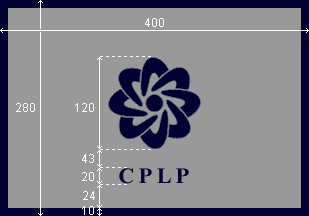
image by Francisco Grigoric, Sammy Kanadi
and António Martins, 01 Nov 2006
I wrote to the CPLP webmaster regarding their flag and got a reply. Here
it is (my translation):
Dear Sir,
Contrarily to what some sources may tell you, the correct version
of the flag is the one that has the blue border. So, in a flag with
2×1,40 m, the border has 5 cm, the characters "CPLP" have
10 cm of height and the logo has 60cm of diameter. The characters
are 12 cm away from the logo and 21,5 cm away from the bottom
border.
Concerning the meaning of the logo, contrarilily to what is commonly
believed, it has a meaning: Having the circle as the geometric base, it
was decided to divide it in seven equal parts, the same as the number
of countries of the CPLP. It was used an element on the shape of a wave,
representing the sea, that before the common language, was the element
that first united those countries. In the centre of this structure a
circle concentric to the structure, represents the union element
nowadays — the language.
Yours truly,
Executive Chairmanship of the
Commonwealth of Portuguese-Speaking Countries
João Madureira, 15 August 1998The fact that the number of “fingers” [waves] equals the
number of members creates a problem: with each change in
membership, the logo has to be changed.
Now, these days all portuguese-speaking countries are members. But they can
leave the organization. And, what is much more unlikely, other members
might join in if. This is to say that the choice of such a mutable emblem
was not very bright, in my humble opinion.
Jorge Candeias, 19 Mar 2004
There’s always the US solution (stripes)
— keep the number the same.
Nathan Lamm, 19 Mar 2004
Former flag
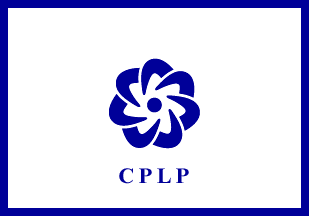
image by Sammy Kanadi, 2003
Seven members: all the lusophonous countries
(Portugal, Brazil,
Angola, Mozambique,
Cape Verde, Guinea-Bissau
and São Tome e Príncipe) and
East Timor as an observer.
Jorge Candeias, 03 Dec 1998
Variations of the flag
Wide border and large logo
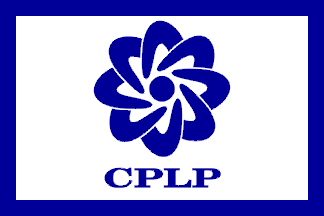
image by Francisco Grigoric, 01 Nov 2006
While the exact specifications of the CPLP flag are those shown above,
not all flags are made to these specifications. This variant was made
from observed flags.
António Martins-Tuvalkin, 24 Aug 2000
The Album [pay00] provides
official CMYK shade as 100-95-20-0 (with Pantone approximation 2755c, that
is also a bit purpleish). The emblem is somewhat bigger then in the image
from the reported official patern.
Željko Heimer, 05 Dec 2003
Since Album [pay00] provides
official colours, it would be reasonable to assume that this was based on
official info too, and that would probably also include the image. Of course,
there may be a number of other influences in the game — from
illustrator’s error to the fact that we deal with two
“contradictory” offical sources —
this last would not surprise me at all.
Željko Heimer, 05 Dec 2003
Me neither. It happens all the time. There are two other possibilities
that cannot be excluded, though: today’s specs differing from what
was used a few years ago, and people in different offices
not talking to eachother and coming up with different numbers, each on its
own. It would be interesting to know the source for the Album
[pay00].
Jorge Candeias, 06 Dec 2003
No border and large logo
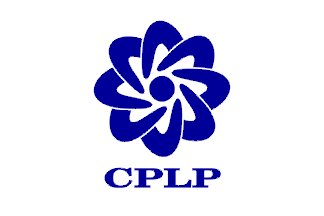
image by Francisco Grigoric, 01 Nov 2006
Recently the CPLP has been on the news quite frequently, mainly due
to the civil war that is going on in Guinea-Bissau. These unfortunate
happenings gave rise, as usual, to some flag-sightings on TV, including
a surprise: a CPLP flag without border.
The picture I made before was made from a black and white photo, and
I made some educated guesses on colours to make it. The flag in the photo
has a border very clearly visible. But now on TV, I saw a flag with no
border, though the rest is exactly as I depicted it: dimensions and
colours.
I saw this arrangement before on the Expo’98 webpages, but I thought
it was a(nother) mistake. Obviously it wasn’t, but now I wander: wich is
the correct flag? Was the bordered flag an early version of the definitive
borderless flag? Why did they make a bad flag even worse by removing the
only original feature it had?
Jorge Candeias, 23 Jul 1998
In today’s newspaper Correio da Manhã, there is another
photo of a CPLP event with the CPLP flag visible and… it has a border!
So it seems they are using the flag with and without the border at the same
time. I wonder if there is some protocolar difference in it’s use, but
I sincerely doubt it. Here I tend to agree with António when he says (in
our private conversations) that it must be due to carelessness.
Jorge Candeias, 04 Aug 1998
The CPLP site shows
a
very small picture with the flag, where it seems to have no border.
Jorge Candeias, 09 Dec 2003
Fringe and full name
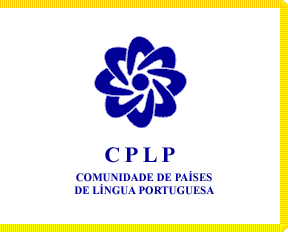
image by Francisco Grigoric and António Martins, 01 Nov 2006
Yet another “version” of the flag appeared yesterday on the
news: white with the logo and acronym, plus the words "COMUNIDADE
DE PAÍSES "¶" DE LÍNGUA
PORTUGUESA" below in two rows and no border. Instead it had a
yellow fringe! This was a part of those flag-art graphical designs that have
become common in recent years, but had a distinctive photo-look. Another flag
in use?!
Jorge Candeias, 21 Aug 1998
 zachary harden
zachary harden






